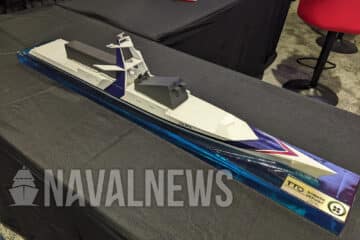The KUZGUN-KY (solid-fuel) missile was successfully fired from the MARLIN Armed Unmanned Marine Vehicle (USV) developed by ASELSAN and Sefine Shipyard for the needs of the Turkish Navy. The KUZGUN-KY missile was fired by remote control in the presence of SSB and Turkish naval officials, which has a Mission Control Station. The test firing was conducted in Saros Bay in the northern Aegean Sea.
The event marked the first RF-guided missile firing from a USV.
“We continue to add new capabilities to our unmanned sea vehicles. The launch of the KUZGUN solid-fuel cruise missile from MARLIN marked the first time guided munitions were fired from a USV.”
Ismail Demir, Head of Turkish Defence Agency
Here is the video of the test firing;
As Naval News previously reported, the Turkish SEFİNE Shipyard and ASELSAN unveiled the brand-new MARLIN USV in two NATO exercises in the second half of September 2022, which marked Turkiye’s first participation to REPMUS NATO exercise with unmanned systems.
According to SEFİNE and ASELSAN, the Marlin is one of the most capable USV to date, thanks to its size, payload, configuration adaptability, and especially its electronic warfare (EW) capabilities, which can be considered a “first” in the field. The payload of MARLIN during the NATO exercises were specifically for EW. The 15-meter ship will provide fleets with off-board jammers, which would be beneficial for surface warfare.
KUZGUN-KY, a new-generation surface-launched missile, has been added as a major force multiplier to MARLIN’s existing capabilities. MARLIN has increased its firepower and combat capability by integrating KUZGUN-KY, a medium-range missile with next-generation guidance and effective warhead capabilities.

Author’s comment
The launch of a surface-to-surface missile by a USV marks a breakthrough in Turkiye’s unmanned systems capabilities. The Turkish defense industry has worked on several USV projects, and all of these combat USVs are armed with a missile turret capable of firing laser-guided L-UMTAS and Cirit missiles. The ability to launch “fire and forget” missiles with a range of 40 kilometers and represents a new breakthrough in combat USV capabilities.
Given MARLIN ‘s high payload capacity, it will likely be able to deploy dozens of KUZGUN missiles, which will give the Turkish Navy significant firepower. Naval warfare has evolved and the importance of unmanned systems is becoming clearer by the day. A naval drone that can operate up to sea state 5, carry dozens of medium-range missiles, and have electronic warfare capabilities is an important feature. If these USVs are integrated in a solid CONOPS with the UAVs and manned units, this can be considered a strong tactical option.
After this test launch, two new developments are expected for the firepower of MARLIN. The first is an increase in the range of the KUZGUN, and the second is the arming of the USV with Roketsan CAKIR anti-ship missiles. CAKIR has a range of 150 kilometers and features infrared imaging (IIR) and data link guidance. Roketsan stated that CAKIR can also be launched from UAVs and USVs. CAKIR would thus be an important weapon option for Turkish USVs, including MARLIN.
About MARLIN RD09 USV

MARLIN is an autonomous USV designed to meet the high speed, sea keeping and maneuverability requirements. The company didn’t share the dimensions and the endurance of the USV due to the confidentiality concerns, but available data suggests that the vessels optimal speed is 12 knots and it can exceed a top speed 36 knots. In addition, MARLIN is rather large, with a length of about 15 meters and a large payload capacity. MARLIN’s special hull form, propulsion system, and auxiliaries, allow it to operate up to Sea State 4 (and navigate in rough seas up to Sea State 5).
It can be configured as an anti-surface warfare (ASUW) with guided missiles, and anti-submarine warfare (ASW) with torpedoes.
According to SEFINE, MARLIN can easily be fitted with different types of payloads (SSM, Torpedo, EW, Sonobuoy, SATCOM, LOS Communication, Underwater communication…) in order to meet operational needs with both monohull and trimaran hull forms as well as optimized for endurance figures.
About Kuzgun-KY anti-ship missile

The Kuzgun precision-guided munition is a new-generation product family in the 100-kg class that meets tactical guided munition requirements, is modular in propulsion and methods of navigation or warhead control, has low cost, is reusable, has high hit accuracy and low lateral damage.
The Kuzgun guided munitions series offers a variety of warheads (splitter, thermobar, general-purpose, and penetrator), guidance methods (INS /GPS or INS only ), and seekers (imaging infrared – IIR, millimeter-wave radar or laser).
As part of the KUZGUN project, TUBİTAK- SAGE is developing three different missiles in solid-fuel (KY), turbojet engine (TJ), and free-fall (SS) configurations. The KY variant is expected to be fitted to USVs, while other variants would be used by the air assets including fighter jets and UCAVs.
The operational ranges of the Kuzgun smart munition/missile family according to variant and launching platforms are given below:
Jet fighter (40.000 ft, dropped with 0.9 Mach speed)
- 180+ km KUZGUN-TJ (Turbojet Engine variant)
- 110+ km KUZGUN-SS (Free fall variant)
Unmanned Combat Aerial Vehicle
- 180+ km KUZGUN-TJ (Turbojet Engine variant)
- 40+ km KUZGUN-SS (Free fall variant)
Naval Assets or land-based launcher
- 100+ km KUZGUN-SS (Free fall variant with an additional launching engine)
- 180+ km KUZGUN-TJ (Free fall variant with an additional launching engine)
- 40+ km KUZGUN-KY (Solid Fuel Engine) (This variant will be deployed from USVs)






